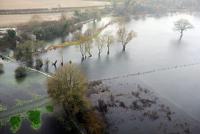-
HAZARDOUS MATERIALSTransporting Hazardous Materials Across the Country Isn’t Easy − That’s Why There’s a Host of Regulations in Place
Transporting hazardous materials such as dangerous gases, poisons, harmful chemicals, corrosives and radioactive material across the country is risky. But because approximately 3 billion pounds of hazardous material needs to go from place to place in the U.S. each year, it’s unavoidable.
-
-
WildfiresWe Can’t Predict the Next Wildfire Disaster – but We Can Plan for It
When it comes to wildfire threats to communities, we are navigating uncharted waters. Under extreme conditions, we cannot stop a spreading wildfire. When they occur, the only option is to contain it or evacuate. So start planning your route now.
-
-
ResilienceEngineers and Economists Prize Efficiency, but Nature Favors Resilience – Lessons from Texas, COVID-19 and the 737 Max
The damage from Winter Storm Uri, the economic devastation from the COVID-19 pandemic and the fatal Boeing 737 Max accidents show the price society pays for a relentless pursuit of efficiency. Modern society has prioritized free-market economics and efficient computer systems to the detriment of other priorities. Studies of algorithms show that efficiency can come at a high cost. Sexual reproduction and car insurance highlight the benefits of resilience.
-
-
InfrastructureBrazil: Court Accepts Homicide Charges over Dam Collapse Which Killed 270
In January 2019, more than 270 were killed, thousands of homes destroyed, and large tracts of agricultural land poisoned when Brazil’s Brumadinho dam collapsed, releasing tons of toxic sludge. Last week, a Brazilian judge accepted the prosecution’s argument that 16 employees of Brazilian mining giant Vale the company’s German safety auditor should stand trial for intentional homicide. Documents show that Vale’s former CEO and the German auditors colluded to falsify engineering reports which warned about the dam’s structural weakness. Separately, German prosecutors said that they would file charged of negligent homicide and bribery against the German safety auditors.
-
-
Climate mitigationThe Hidden Politics of Climate Engineering
At this point, the greatest danger of climate engineering may be how little is known about where countries stand on these potentially planet-altering technologies. Who is moving forward? Who is funding research? And who is being left out of the conversation?
-
-
FloodsTwitter, citizen science, and AI help improve flood data collection
Urban flooding is difficult to monitor due to complexities in data collection and processing. This prevents detailed risk analysis, flooding control, and the validation of numerical models. Researchers are combining Twitter, citizen science and cutting-edge artificial intelligence (AI) techniques to develop an early-warning system for flood-prone communities.
-
-
Human-induced earthquakesGeologists report new findings about Kansas, Oklahoma earthquakes
In the more than three decades between 1977 and 2012, only 15 earthquakes with a magnitude of 3.0 or greater were recorded in the entire state of Kansas. Since 2012 more than 100 earthquakes of 3.0 or greater have been recorded in only two counties in the state, Sumner and Harper. These include the largest earthquake ever monitored in Kansas in November 2014, a magnitude 4.9 event near the Sumner County town of Milan. The frequency of earthquakes has continued to increase. Between May 2015 and July 2017, sensors detected more than 2,400 earthquakes in Sumner County alone, ranging in magnitude from 0.4 to 3.6. As concern rises about earthquakes induced by human activity like oil exploration, geologists report a new understanding about recent earthquakes in Kansas and Oklahoma.
-
-
Disaster warningWorst-case scenarios: Why we should welcome warnings

Nuclear accidents. Sea level rise. Terror threats. The world is full of potential catastrophes, but most of the time, most of us are oblivious to them. Still, at times, experts warn the rest of us about these potential crises. Sometimes those warnings work, but many times they go unheeded. Why do we ignore information we could use to stave off a disaster? Richard Clarke, the former chief counter-terrorism advisor on the National Security Council, says that we should be more receptive to the possibility of dire news, as well as more systematic about analyzing it. In his new book, Warnings, Clarke asserts that specialists in a range of fields can “see the thing buried in the data that other people don’t see. They see it first.”
-
-
EarthquakesThe “Really Big One”: How a 9.0 Cascadia earthquake could play out
One of the worst nightmares for many Pacific Northwest residents is a huge earthquake along the offshore Cascadia Subduction Zone, which would unleash damaging and likely deadly shaking in coastal Washington, Oregon, British Columbia and northern California. The last time this happened was in 1700, before seismic instruments were around to record the event. So what will happen when it ruptures next is largely unknown.
-
-
Climate change threatsWarming seas could lead to 70 percent increase in hurricane-related financial loss
If oceans warm at a rate predicted by the Intergovernmental Panel on Climate Change, the UN-sponsored group that assesses climate change research and issues periodic reports, expected financial losses caused by hurricanes could increase more than 70 percent by 2100, according to researchers. The finding is based on the panel’s most severe potential climate change scenario – and resulting increased sea surface temperature – and is predicted at an 80 percent confidence level. The model drew on hurricane data for the last 150 years gathered by NOAA.
-
-
DisastersKnowing more and loosing less: Science and helps in disaster risk management
Natural and man-made disasters threaten millions of people every year and cause billions of property damage. How much do we know about them? And how can we use that knowledge to save lives and money? A recent report —Science for Disaster Risk Management 2017: Knowing More and Losing Less — seeks to answer these and other questions and to help prepare for the time when disaster strikes.
-
-
Emerging threatsRisk analysis for common ground on climate loss and damage
The Paris Agreement included groundbreaking text on the need for a mechanism to help identify risks beyond adaptation and support the victims of climate-related loss and damage — but how exactly it will work remains unclear. The question of how to deal with dangerous climate change as being experienced and perceived by developing countries and communities has been one of the most contentious questions in international climate negotiations.
-
-
Risk assessmentNew tool to measure homeland security risks
DHS has a broad and complex mission, with priorities that include preparing for and responding to a range of terrorist events, natural disasters, and major accidents.Researchers have applied a tool originally developed to address risks in environmental policy, the Deliberative Method for Ranking Risk, to aid in strategic planning for security.
-
-
FloodsIncreasing speed, accuracy of flood risk assessment
New research hopes to provide advances in the planning for flood risk, thanks to a new, faster method of assessing the highly complex factors that cause floods in a specific location. The results of the study have shown it is possible to increase the speed of a highly accurate flood risk prediction by between 100-1,000 times compared with techniques currently used by researchers to estimate flood risk under climate change.
-
-
Emerging threatsU.K. government rejected flood warnings from own advisers

Critics charge that the U.K. government was warned by both the government’s own climate change experts and outside consultants that there was a need to take urgent action to protect the increasing number areas in Britain which are becoming susceptible to flooding, but that the government rejected the advice. Despite the urging of its own climate experts, the U.K. government in October, just a few weeks before the devastating flooding in Cumbria, decided not to develop comprehensive strategy to address flood risk.
-
- All
- Regional
- Water
- Biometrics
- Borders/Immig
- Business
- Cybersecurity
- Detection
- Disasters
- Government
- Infrastructure
- International
- Public health
- Public Safety
- Communication interoperabillity
- Emergency services
- Emergency medical services
- Fire
- First response
- IEDs
- Law Enforcement
- Law Enforcement Technology
- Military technology
- Nonlethal weapons
- Nuclear weapons
- Personal protection equipment
- Police
- Notification /alert systems
- Situational awareness
- Weapons systems
- Sci-Tech
- Sector Reports
- Surveillance
- Transportation
Advertising & Marketing: advertise@newswirepubs.com
Editorial: editor@newswirepubs.com
General: info@newswirepubs.com
2010-2011 © News Wire Publications, LLC News Wire Publications, LLC
220 Old Country Road | Suite 200 | Mineola | New York | 11501
Permissions and Policies
Editorial: editor@newswirepubs.com
General: info@newswirepubs.com
2010-2011 © News Wire Publications, LLC News Wire Publications, LLC
220 Old Country Road | Suite 200 | Mineola | New York | 11501
Permissions and Policies
